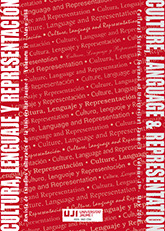Conexión textual y modelos comunicativos: la elaboración paratáctica en el discurso periodístico informativo
Main Article Content
Abstract
Downloads
Article Details
An open-access CREATIVE COMMONS copyright license is used. Those authors whose works are published by this journal, accept the following terms:
- Authors will retain their copyright and guarantee the Journal the right to first publish their work, which will simultaneously be subject to the Creative Commons Recognition License CC BY SA that allows third parties to share the work, provided that its author and first publication is indicated.
- Authors may adopt other non-exclusive license agreements for the distribution of the published version of the work (e.g., deposit it in an institutional telematics file or publish it in a monographic volume) provided that the initial publication in this journal is indicated.
- Authors are allowed and recommended to disseminate their work over the Internet (e.g. in institutional telematics files or on their website) before and during the submission process, which can produce interesting exchanges and increase quotes of the published work.
References
ALCÍBAR, M. (2004): «La divulgación mediática de la ciencia y la tecnología como recontextualización discursiva», Anàlisi, 31: 43-70.
ANTOS, G. (1982): Grundlagen einer Theorie des Formulierens. Tübingen: Niemeyer.
BRIZ, A., SALVADOR PONS y JOSÉ PORTOLÉS (coords.) (2008): Diccionario de partículas discursivas del español. En línea, www.dpde.es
CARMONA YANES, E. (2016): El lector (inter)activo en la prensa escrita española, Tesis doctoral, Universidad de Sevilla.
CHILLÓN, A. (2001): «El ‘giro lingüístico’ en periodismo y su incidencia en la comunicación periodística», Cuadernos de Información, 14 (enero-diciembre): 24-47. Pontificia Universidad Católica de Chile.
DOWNING, A., y PHILIP LOCKE (1992): A University Course in English Grammar. London: Prentice- Hall.
EGBERT, M. (2009): Der Reparatur-Mechanismus in deutschen Gesprächen. Mannheim: Verlag für Gesprächsforschung.
EGGINS, S. y JAMES ROBERT MARTIN (2003): «El contexto como género: una perspectiva lingüística funcional», Revista Signos, 36 (54): 185-205.
ESTEVE RAMÍREZ, F. (2004). «Información económica». En J. Fernández del Moral (Coord.), Periodismo especializado. Barcelona: Ariel, pp. 263- 284.
GONZÁLEZ RODRÍGUEZ, M.J. (2003): «Relaciones lógico-semánticas y su forma de expresión en el género noticia», Atlantis, 25.2: 55-59.
HALLIDAY, MICHAEL A.K. (1985): An Introduction to Functional Grammar. London: Edward Arnold.
--- y RUQAIYA HASAN (1976): Cohesion in English. New York: Longman.
--- y Christian M.I.M. MATTHIESSEN (2014): Halliday’s Introduction to Functional Grammar. London: Routledge.
KOCH, P. y OESTERREICHER, W. (1985): «Sprache der Nahë –Sprache der Distanz. Münd-lichkeit und Schriftlichkeit im Spannungsfeld von Sprachtheorie und Sprachgeschichte», Romanistisches Jahrbuch, 36: 15-43.
MANCERA RUEDA, A. (2008): «La reformulación en el discurso periodístico: una muestra de oralidad», Oralia, 11: 353-374.
MARTÍN ZORRAQUINO, M. y JOSÉ PORTOLÉS (1999): «Los marcadores del discurso», en I. Bosque y V. Demonte (dirs.), vol. III: 4051-4213.
RATH, R. (1979): Kommunikationspraxis: Analysen zur Textbildung und Textgliederung im gespro- chenen Deutsch. Göttingen: Vandenhoeck & Ruprecht.
ROBLES I SABATER, F. (2014): «Estructura informativa y reformulación: los recapitulativos kurz gesagt y mit einem Wort», Revista de Filología Alemana, 22, 207-226.
SALVADOR, V. (2002): «Discurso periodístico y gestión social de los conocimientos: algunas observaciones sobre la didacticidad», Anàlisi, 28: 107-120.
VAN DIJK, TEUN A. (1990): La noticia como discurso: comprensión, estructura y producción de la información. Barcelona: Paidós.
VARGAS, E. (2007): «Reformulation, apposition et structures de type appositif», Lyon linguistique allemande, 11.
VELLÓN LAHOZ, J. (2013): «El lenguaje periodístico: del ‘nido de lenguajes’ al ‘giro lingüístico’», Communication&Society, 26, 4: 153-173.
--- (2014): «Divulgación y didacticidad en el discurso periodístico: la información económica durante la crisis», Zer, Revista de estudios de comunicación, 19,36: 99-119.


